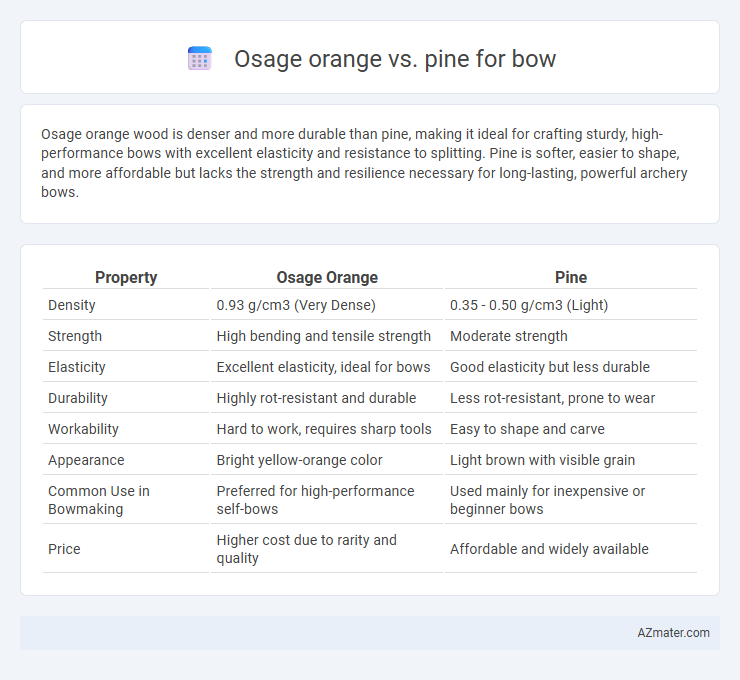Osage orange wood is denser and more durable than pine, making it ideal for crafting sturdy, high-performance bows with excellent elasticity and resistance to splitting. Pine is softer, easier to shape, and more affordable but lacks the strength and resilience necessary for long-lasting, powerful archery bows.
Table of Comparison
| Property | Osage Orange | Pine |
|---|---|---|
| Density | 0.93 g/cm3 (Very Dense) | 0.35 - 0.50 g/cm3 (Light) |
| Strength | High bending and tensile strength | Moderate strength |
| Elasticity | Excellent elasticity, ideal for bows | Good elasticity but less durable |
| Durability | Highly rot-resistant and durable | Less rot-resistant, prone to wear |
| Workability | Hard to work, requires sharp tools | Easy to shape and carve |
| Appearance | Bright yellow-orange color | Light brown with visible grain |
| Common Use in Bowmaking | Preferred for high-performance self-bows | Used mainly for inexpensive or beginner bows |
| Price | Higher cost due to rarity and quality | Affordable and widely available |
Osage Orange vs Pine: Overview
Osage Orange is highly prized for bow making due to its exceptional strength, density, and elasticity, which provide superior durability and performance compared to Pine. Pine, while more readily available and easier to work with, lacks the same level of tensile strength and resilience, leading to less effective bows. Osage Orange's natural resistance to rot and its tight grain structure contribute to its status as a premium woodworking choice for traditional archery bows.
Wood Characteristics and Grain Structure
Osage orange wood is dense, hard, and highly resilient with a tight, interlocked grain structure that offers exceptional strength and shock resistance, making it ideal for powerful, durable bows. Pine, by contrast, features a lighter, softer texture with a straighter but less dense grain, providing flexibility but less overall durability and strength in bow construction. The superior hardness and complex grain of Osage orange contribute to greater longevity and performance under tension compared to the more prone-to-splitting, softer pine wood.
Durability and Longevity Comparison
Osage orange wood is renowned for its exceptional durability and resistance to wear, making it highly suitable for long-lasting bows, with natural oils that enhance its moisture resistance and prevent decay. Pine, while easier to work with and lighter, lacks the density and toughness of Osage orange, resulting in bows that are less durable and more susceptible to damage over time. The superior fiber strength and rot resistance of Osage orange translate into bows with significantly extended longevity compared to those crafted from pine.
Flexibility and Performance in Bow Making
Osage orange wood exhibits superior flexibility and elasticity compared to pine, making it highly favored for bow making due to its ability to absorb and store energy efficiently. Its dense grain structure provides excellent tension strength, resulting in durable and resilient bows with optimal performance. In contrast, pine lacks the necessary tensile properties, often leading to bows that are less flexible and prone to warping under stress.
Weight and Draw Efficiency
Osage orange wood offers a heavier density of approximately 60-70 lbs per cubic foot, providing superior draw efficiency due to its excellent elasticity and high energy storage compared to pine, which typically weighs around 25-35 lbs per cubic foot. The higher weight of Osage orange translates into greater momentum and faster arrow speed, making it a preferred choice for traditional bowyers seeking power and durability. Pine, being lighter and less dense, yields lower draw efficiency and reduced arrow velocity, making it suitable mainly for beginner bows or lightweight hunting scenarios.
Ease of Shaping and Workability
Osage orange wood is denser and harder, making it more challenging to shape but offering superior strength and durability for bows. Pine, being softer and lighter, is easier to carve and shape, especially for beginners, though it lacks the resilience needed for high-performance bows. Craftsmen often prefer Osage orange for its excellent workability despite increased effort, while pine is favored for quick, simple projects.
Cost and Availability of Materials
Osage orange wood is generally pricier due to its limited availability and slower growth compared to pine, which is widely accessible and more affordable. The dense, durable Osage orange provides superior strength and elasticity, justifying its higher cost for high-quality bows. Pine bows are less expensive and easier to source but may lack the resilience and longevity of Osage orange in bow applications.
Suitability for Beginner vs Experienced Bowyers
Osage orange is highly prized by experienced bowyers for its exceptional strength, elasticity, and dense grain, making it ideal for traditional longbows and flatbows that demand superior performance and durability. Pine, often favored by beginners, offers easier workability and faster growth, allowing novices to practice shaping and tillering without the challenges posed by harder woods. While Osage orange requires advanced skills to avoid damage during crafting, pine provides a forgiving material that supports learning bow-making fundamentals before progressing to more demanding hardwoods.
Traditional Uses in Archery
Osage orange wood is highly valued in traditional archery for its exceptional strength, flexibility, and resistance to compression, making it ideal for self bows and longbows that require durability and smooth draw cycles. Pine, while more readily available and easier to work with, lacks the density and resilience of Osage orange, often resulting in bows that are less powerful and prone to warping or breaking under tension. Archers seeking historically authentic and high-performance traditional bows typically prefer Osage orange due to its proven track record among Native American and early American bowyers.
Final Verdict: Which Wood is Better for Bows?
Osage orange wood offers exceptional strength, durability, and excellent tensile properties, making it one of the best traditional bow woods for powerful, long-lasting bows. Pine, while easier to work with and lighter, lacks the density and stiffness of Osage orange, resulting in less efficient energy storage and lower durability for bows. For archers seeking optimal performance and longevity, Osage orange is the superior choice for bow-making.

Infographic: Osage orange vs Pine for Bow
 azmater.com
azmater.com